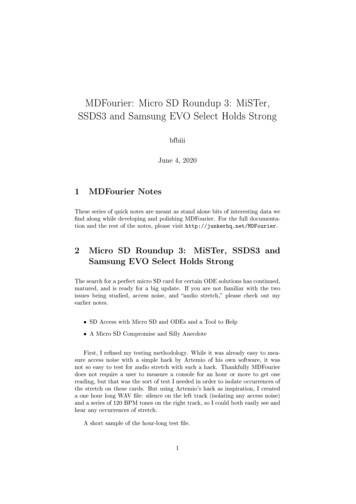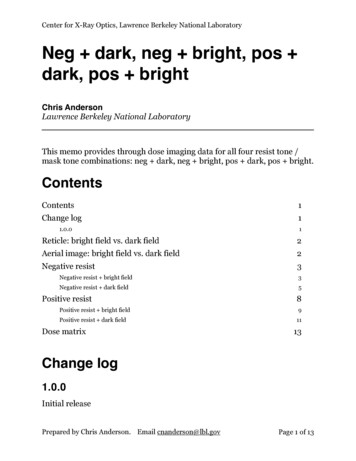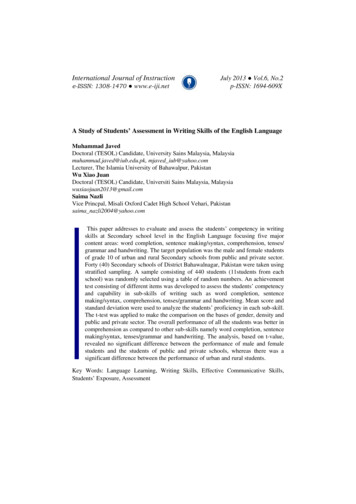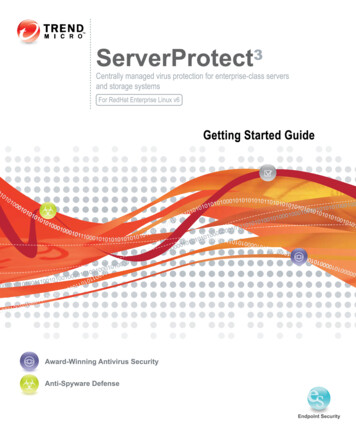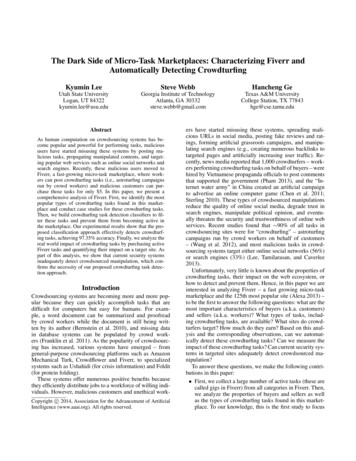
Transcription
The Dark Side of Micro-Task Marketplaces: Characterizing Fiverr andAutomatically Detecting CrowdturfingKyumin LeeSteve WebbHancheng GeUtah State UniversityLogan, UT 84322kyumin.lee@usu.eduGeorgia Institute of TechnologyAtlanta, GA 30332steve.webb@gmail.comTexas A&M UniversityCollege Station, TX 77843hge@cse.tamu.eduAbstractAs human computation on crowdsourcing systems has become popular and powerful for performing tasks, malicioususers have started misusing these systems by posting malicious tasks, propagating manipulated contents, and targeting popular web services such as online social networks andsearch engines. Recently, these malicious users moved toFiverr, a fast-growing micro-task marketplace, where workers can post crowdturfing tasks (i.e., astroturfing campaignsrun by crowd workers) and malicious customers can purchase those tasks for only 5. In this paper, we present acomprehensive analysis of Fiverr. First, we identify the mostpopular types of crowdturfing tasks found in this marketplace and conduct case studies for these crowdturfing tasks.Then, we build crowdturfing task detection classifiers to filter these tasks and prevent them from becoming active inthe marketplace. Our experimental results show that the proposed classification approach effectively detects crowdturfing tasks, achieving 97.35% accuracy. Finally, we analyze thereal world impact of crowdturfing tasks by purchasing activeFiverr tasks and quantifying their impact on a target site. Aspart of this analysis, we show that current security systemsinadequately detect crowdsourced manipulation, which confirms the necessity of our proposed crowdturfing task detection approach.IntroductionCrowdsourcing systems are becoming more and more popular because they can quickly accomplish tasks that aredifficult for computers but easy for humans. For example, a word document can be summarized and proofreadby crowd workers while the document is still being written by its author (Bernstein et al. 2010), and missing datain database systems can be populated by crowd workers (Franklin et al. 2011). As the popularity of crowdsourcing has increased, various systems have emerged – fromgeneral-purpose crowdsourcing platforms such as AmazonMechanical Turk, Crowdflower and Fiverr, to specializedsystems such as Ushahidi (for crisis information) and Foldit(for protein folding).These systems offer numerous positive benefits becausethey efficiently distribute jobs to a workforce of willing individuals. However, malicious customers and unethical workCopyright c 2014, Association for the Advancement of ArtificialIntelligence (www.aaai.org). All rights reserved.ers have started misusing these systems, spreading malicious URLs in social media, posting fake reviews and ratings, forming artificial grassroots campaigns, and manipulating search engines (e.g., creating numerous backlinks totargeted pages and artificially increasing user traffic). Recently, news media reported that 1,000 crowdturfers – workers performing crowdturfing tasks on behalf of buyers – werehired by Vietnamese propaganda officials to post commentsthat supported the government (Pham 2013), and the “Internet water army” in China created an artificial campaignto advertise an online computer game (Chen et al. 2011;Sterling 2010). These types of crowdsourced manipulationsreduce the quality of online social media, degrade trust insearch engines, manipulate political opinion, and eventually threaten the security and trustworthiness of online webservices. Recent studies found that 90% of all tasks incrowdsourcing sites were for “crowdturfing” – astroturfingcampaigns run by crowd workers on behalf of customers– (Wang et al. 2012), and most malicious tasks in crowdsourcing systems target either online social networks (56%)or search engines (33%) (Lee, Tamilarasan, and Caverlee2013).Unfortunately, very little is known about the properties ofcrowdturfing tasks, their impact on the web ecosystem, orhow to detect and prevent them. Hence, in this paper we areinterested in analyzing Fiverr – a fast growing micro-taskmarketplace and the 125th most popular site (Alexa 2013) –to be the first to answer the following questions: what are themost important characteristics of buyers (a.k.a. customers)and sellers (a.k.a. workers)? What types of tasks, including crowdturfing tasks, are available? What sites do crowdturfers target? How much do they earn? Based on this analysis and the corresponding observations, can we automatically detect these crowdturfing tasks? Can we measure theimpact of these crowdturfing tasks? Can current security systems in targeted sites adequately detect crowdsourced manipulation?To answer these questions, we make the following contributions in this paper: First, we collect a large number of active tasks (these arecalled gigs in Fiverr) from all categories in Fiverr. Then,we analyze the properties of buyers and sellers as wellas the types of crowdturfing tasks found in this marketplace. To our knowledge, this is the first study to focus
primarily on Fiverr. Second, we conduct a statistical analysis of the properties of crowdturfing and legitimate tasks, and we builda machine learning based crowdturfing task classifier toactively filter out these existing and new malicious tasks,preventing propagation of crowdsourced manipulation toother web sites. To our knowledge this is the first studyto detect crowdturfing tasks automatically. Third, we feature case studies of three specific types ofcrowdturfing tasks: social media targeting gigs, searchengine targeting gigs and user traffic targeting gigs. Finally, we purchase active crowdturfing tasks targetinga popular social media site, Twitter, and measure theimpact of these tasks to the targeted site. We then testhow many crowdsourced manipulations Twitter’s security can detect, and confirm the necessity of our proposedcrowdturfing detection approach.BackgroundFiverr is a micro-task marketplace where users can buy andsell services, which are called gigs. The site has over 1.7million registered users, and it has listed more than 2 milliongigs1 . As of November 2013, it is the 125th most visited sitein the world according to Alexa (Alexa 2013).Fiverr gigs do not exist in other e-commerce sites, andsome of them are humorous (e.g., “I will paint a logo onmy back” and “I will storyboard your script”). In the marketplace, a buyer purchases a gig from a seller (the defaultpurchase price is 5). A user can be a buyer and/or a seller.A buyer can post a review about the gig and the corresponding seller. Each seller can be promoted to a 1st level seller,a 2nd level seller, or a top level seller by selling more gigs.Higher level sellers can sell additional features (called “gigextras”) for a higher price (i.e., more than 5). For example, one seller offers the following regular gig: “I will writea high quality 100 to 300 word post,article,etc under 36 hrsfree editing for 5”. For an additional 10, she will “makethe gig between 600 to 700 words in length”, and for an additional 20, she will “make the gig between 800 to 1000words in length”. By selling these extra gigs, the promotedseller can earn more money. Each user also has a profile pagethat displays the user’s bio, location, reviews, seller level,gig titles (i.e., the titles of registered services), and numberof sold gigs.Figure 1 shows an example of a gig listingon Fiverr. The listing’s human-readable URL -editing, whichwas automatically created by Fiverr based on the title of thegig. The user name is “hdsmith7674”, and the user is a toprated seller.Ultimately, there are two types of Fiverr sellers: (1) legitimate sellers and (2) unethical (malicious) sellers, as shownin Figure 2. Legitimate sellers post legitimate gigs that donot harm other users or other web sites. Examples of r/Figure 1: An example of a Fiverr gig listing.gitimate gigs are “I will color your logo” and “I will singa punkrock happy birthday”. On the other hand, unethicalsellers post crowdturfing gigs on Fiverr that target sites suchas online social networks and search engines. Examples ofcrowdturfing gigs are “I will provide 2000 perfect lookingtwitter followers” and “I will create 2,000 Wiki Backlinks”.These gigs are clearly used to manipulate their targeted sitesand provide an unfair advantage for their buyers.Fiverr CharacterizationIn this section, we present our data collection methodology.Then, we measure the number of the active Fiverr gig listings and estimate the number of listings that have ever beencreated. Finally, we analyze the characteristics of Fiverr buyers and sellers.DatasetTo collect gig listings, we built a custom Fiverr crawler. Thiscrawler initially visited the Fiverr homepage and extractedits embedded URLs for gig listings. Then, the crawler visitedeach of those URLs and extracted new URLs for gig listingsusing a depth-first search. By doing this process, the crawleraccessed and downloaded each gig listing from all of the gigcategories between July and August 2013. From each listing, we also extracted the URL of the associated seller anddownloaded the corresponding profile. Overall, we collected89,667 gig listings and 31,021 corresponding user profiles.Gig AnalysisFirst, we will analyze the gig listings in our dataset and answer relevant questions.How much data was covered? We attempted to collect every active gig listing from every gig category in Fiverr. Tocheck how many active listings we collected, we used asampling approach. When a listing is created, Fiverr internally assigns a sequentially increasing numerical id to thegig. For example, the first created listing received 1 as theid, and the second listing received 2. Using this numberscheme, we can access a listing using the following URL format: http://Fiverr.com/[GIG NUMERICAL ID], which will
purchaseMicro-Task MarketplaceGigpost③②purchaseGigLegit Seller Buyer① postPerforming thecrowdturfing tasksTarget SitesSocial NetworksForums & ReviewSearch EnginesBlogsUnethical SellerGigBuyerGigGigGigGigGigLegit TaskGigCrowdturfing TaskFigure 2: The interactions between buyers and legitimate sellers on Fiverr, contrasted with the interactions between buyers andunethical sellers.How many gigs have been created over time? A gig listingcontains the gig’s numerical id and its creation time, which isdisplayed as days, months, or years. Based on this information, we can measure how many gigs have been created overtime. In Figure 3, we plotted the approximate total numberof gigs that have been created each year. The graph followsthe exponential distribution in macro-scale (again, yearly)even though the micro-scaled plot may show us a clearergrowth rate. This plot shows that Fiverr has been gettingmore popular, and in August 2013, the site reached 2 million listed gigs.User AnalysisFigure 3: Total number of created gigs over time.be redirected to the human-readable URL that is automatically assigned based on the gig’s title.As part of our sampling approach, we sampled 1,000gigs whose assigned id numbers are between 1,980,000and 1,980,999 (e.g., http://Fiverr.com/1980000). Then, wechecked how many of those gigs are still active because gigsare often paused or deleted. 615 of the 1,000 gigs were stillactive. Next, we crossreferenced these active listings withour dataset to see how many listings overlapped. Our datasetcontained 517 of the 615 active listings, and based on thisanalysis, we can approximate that our dataset covered 84%of the active gigs on Fiverr. This analysis also shows that giglistings can become stale quickly due to frequent pauses anddeletions.Initially, we attempted to collect listings using gig id numbers (e.g., http://Fiverr.com/1980000), but Fiverr’s SafetyTeam blocked our computers’ IP addresses because accessing the id-based URLs is not officially supported by the site.To abide by the site’s policies, we used the human-readableURLs, and as our sampling approach shows, we still collected a significant number of active Fiverr gig listings.Next, we will analyze the characteristics of Fiverr buyersand sellers in the dataset.Where are sellers from? Are the sellers distributed allover the world? In previous research, sellers (i.e., workers)in other crowdsourcing sites were usually from developingcountries (Lee, Tamilarasan, and Caverlee 2013). To determine if Fiverr has the same demographics, Figure 4(a) showsthe distribution of sellers on the world map. Sellers are from168 countries, and surprisingly, the largest group of sellersare from the United States (39.4% of the all sellers), whichis very different from other sites. The next largest group ofsellers is from India (10.3%), followed by the United Kingdom (6.2%), Canada (3.4%), Pakistan (2.8%), Bangladesh(2.6%), Indonesia (2.4%), Sri Lanka (2.2%), Philippines(2%), and Australia (1.6%). Overall, the majority of sellers(50.6%) were from the western countries.What is Fiverr’s market size? We analyzed the distribution of purchased gigs in our dataset and found that a totalof 4,335,253 gigs were purchased from the 89,667 uniquelistings. In other words, the 31,021 users in our dataset soldmore than 4.3 million gigs and earned at least 21.6 million, assuming each gig’s price was 5. Since some gigscost more than 5 (due to gig extras), the total gig-relatedrevenue is probably even higher. Obviously, Fiverr is a hugemarketplace, but where are the buyers coming from? Fig-
(a) Distribution of sellers in the world map.(b) Distribution of buyers in the world map.Figure 4: Distribution of all sellers and buyers in the world map.Usernamecrorkservicedino etbestoftwitteramazesolutionssarit11 Sold Gigs 23,72599,89099,320Table 1: Top 10 sellers.Eared (Minimum) Gigs Gig Category3,006,05029 Online Marketing1,417,1003 Online Marketing865,15015 Online Marketing and Advertising856,20029 Business, Advertising and Online Marketing839,7253 Online Marketing745,45019 Online Marketing, Business, Advertising627,6506 Graphics & Design, Gift and Fun & Bizarre618,6258 Online Marketing and Advertising499,4501 Online Marketing496,6002 Online Marketingure 4(b) shows the distribution of sold gigs on the worldmap. Gigs were bought from all over the world (208 total countries), and the largest number of gigs (53.6% of the4,335,253 sold gigs) were purchased by buyers in the UnitedStates. The next most frequent buyers are the United Kingdom (10.3%), followed by Canada (5.5%), Australia (5.2%),and India (1.7%). Based on this analysis, the majority of thegigs were purchased by the western countries.Who are the top sellers? The top 10 sellers are listedin Table 1. Amazingly, one seller (crorkservice) has sold601,210 gigs and earned at least 3 million over the past 2years. In other words, one user from Moldova has earned atleast 1.5 million/year, which is orders of magnitude largerthan 2,070, the GNI (Gross National Income) per capitaof Moldova (Bank 2013). Even the 10th highest seller hasearned almost 500,000. Another interesting observation isthat 9 of the top 10 sellers have had multiple gigs that werecategorized as online marketing, advertising, or business.The most popular category of these gigs was online marketing.We carefully investigated the top sellers’ gig descriptionsto identify which gigs they offered and sold to buyers. Gigsprovided by the top sellers (except actualreviewnet) are allcrowdturfing tasks, which require sellers to manipulate aweb page’s PageRank score, artificially propagate a messagethrough a social network, or artificially add friends to a social networking account. This observation indicates that despite the positive aspects of Fiverr, some sellers and e abused the micro-task marketplace, and these crowdturfing tasks have become the most popular gigs. Thesecrowdturfing tasks threaten the entire web ecosystem because they degrade the trustworthiness of information. Otherresearchers have raised similar concerns about crowdturfing problems and concluded that these artificial manipulations should be detected and prevented (Wang et al. 2012;Lee, Tamilarasan, and Caverlee 2013). However, previouswork has not studied how to detect these tasks. For theremainder of this paper, we will analyze and detect thesecrowdturfing tasks in Fiverr.Analyzing and Detecting Crowdturfing GigsIn the previous section, we observed that top sellers haveearned millions of dollars by selling crowdturfing gigs.Based on this observation, we now turn our attention tostudying these crowdturfing gigs in detail and automaticallydetect them.Data Labeling and 3 Types of Crowdturfing GigsTo understand what percentage of gigs in our dataset areassociated with crowdturfing, we randomly selected 1,550out of the 89,667 gigs and labeled them as a legitimateor crowdturfing task. Table 2 presents the labeled distribution of gigs across 12 top level gig categories predefined byFiverr. 121 of the 1,550 gigs (6%) were crowdturfing tasks,which is a significant percentage of the micro-task marketplace. Among these crowdturfing tasks, most of them were
Table 2: Labeled data of randomly selected 1,550 aphics&DesignLifestyleMusic&AudioOnline rans.Total Gigs 9951816734711412320620842011571,550 Crowdturfing 0000.6%6%categorized as online marketing. In fact, 55.3% of all onlinemarketing gigs in the sample data were crowdturfing tasks.Next, we manually categorized the 121 crowdturfing gigsinto three groups: (1) social media targeting gigs, (2) searchengine targeting gigs, and (3) user traffic targeting gigs. 65of the 121 crowdturfing gigs targeted social media sites suchas Facebook, Twitter and Youtube. The gig sellers know thatbuyers want to have more friends or followers on these sites,promote their messages or URLs, and increase the numberof views associated with their videos. The buyers expectthese manipulation to result in more effective informationpropagation, higher conversion rates, and positive social signals for their web pages and products.Another group of gigs (47 of the 121 crowdturfing gigs)targeted search engines by artificially creating backlinks fora targeted site. This is a traditional attack against search engines. However, instead of creating backlinks on their own,the buyers take advantage of sellers to create a large numberof backlinks so that the targeted page will receive a higherPageRank score (and have a better chance of ranking at thetop of search results). The top seller in Table 1 (crorkservice)has sold search engine targeting gigs and earned 3 millionwith 100% positive ratings and more than 47,000 positivecomments from buyers who purchased the gigs. This factindicates that the search engine targeting gigs are popularand profitable.The last gig group (9 of the 121 crowdturfing gigs)claimed to pass user traffic to a targeted site. Sellers in thisgroup know that buyers want to generate user traffic (visitors) for a pre-selected web site or web page. With highertraffic, the buyers hope to abuse Google AdSense, whichprovides advertisements on each buyer’s web page, when thevisitors click the advertisements. Another goal of purchasingthese traffic gigs is for the visitors to purchase products fromthe pre-selected page.To this point, we have analyzed the labeled crowdturfinggigs and identified monetization as the primary motivationfor purchasing these gigs. By abusing the web ecosystemwith crowd-based manipulations, buyers attempt to maximize their profits. In the next section, we will develop anapproach to detect these crowdturfing gigs automatically.ActualTable 3: Confusion matrixPredictedCrowdturfing LegitimateCrowdturfing GigabLegit GigcdDetecting Crowdturfing GigsAutomatically detecting crowdturfing gigs is an importanttask because it allows us to remove the gigs before buyerscan purchase them, and eventually, it will allow us to prohibit sellers from posting these gigs. To detect crowdturfinggigs, we built machine-learned models using the manuallylabeled 1,550 gig dataset.The performance of a classifier depends on the quality offeatures, which have distinguishing power between crowdturfing gigs and legitimate gigs in this context. Our featureset consists of the title of a gig, the gig’s description, a toplevel category, a second level category (each gig is categorized to a top level and then a second level – e.g., “onlinemarketing” as the top level and “social marketing” as thesecond level), ratings associated with a gig, the number ofvotes for a gig, a gig’s longevity, a seller’s response time fora gig request, a seller’s country, seller longevity, seller level(e.g., top level seller or 2nd level seller), a world domination rate (the number of countries where buyers of the gigwere from, divided by the total number of countries), anddistribution of buyers by country (e.g., entropy and standarddeviation). For the title and job description of a gig, we converted these texts into bag-of-word models in which eachdistinct word becomes a feature. We also used tf-idf to measure values for these text features.To understand which feature has distinguishing power between crowdturfing gigs and legitimate gigs, we measuredthe chi-square of the features. The most interesting featuresamong the top features, based on chi-square, are categoryfeatures (top level and second level), a world dominationrate, and bag-of-words features such as “link”, “backlink”,“follow”, “twitter”, “rank”, “traffic”, and “bookmark”.Since we don’t know which machine learning algorithm(or classifier) would perform best in this domain, we triedover 30 machine learning algorithms such as Naive Bayes,Support Vector Machine (SVM), and tree-based algorithmsby using the Weka machine learning toolkit with default values for all parameters (Witten and Frank 2005). We used10-fold cross-validation, which means the dataset containing 1,550 gigs was divided into 10 sub-samples. For a givenclassification experiment using a single classifier, each subsample becomes a testing set, and the other 9 sub-samplesbecome a training set. We completed a classification experiment for each of the 10 pairs of training and testing sets, andwe averaged the 10 classification results. We repeated thisprocess for each machine learning algorithm.We compute precision, recall, F-measure, accuracy, falsepositive rate (FPR) and false negative rate (FNR) as metricsto evaluate our classifiers. In the confusion matrix, Table 3,a represents the number of correctly classified crowdturfing gigs, b (called FNs) represents the number of crowd-
turfing gigs misclassified as legitimate gigs, c (called FPs)represents the number of legitimate gigs misclassified ascrowdturfing gigs, and d represents the number of correctly classified legitimate gigs. The precision (P) of thecrowdturfing gig class is a/(a c) in the table. The recall (R) of the crowdturfing gig is a/(a b). F1 measureof the crowdturfing gig class is 2P R/(P R). The accuracy means the fraction of correct classifications and is(a d)/(a b c d).Overall, SVM outperformed the other classification algorithms. Its classification result is shown in Table 4. Itachieved 97.35% accuracy, 0.974 F1 , 0.008 FPR, and 0.248FNR. This positive result shows that our classification approach works well and that it is possible to automaticallydetect crowdturfing gigs.Table 4: SVM-based classification resultAccuracyF1FPRFNR97.35%0.974 0.008 0.248Detecting Crowdturfing Gigs in the Wild andCase StudiesIn this section, we apply our classification approach to alarge dataset to find new crowdturfing gigs and conduct casestudies of the crowdturfing gigs in detail.Newly Detected Crowdturfing GigsIn this study, we detect crowdturfing gigs in the wild, analyze newly detected crowdturfing gigs, and categorize eachcrowdturfing gig to one of the three crowdturfing types (social media targeting gig, search engine targeting gig, or usertraffic targeting gig) revealed in the previous section.First, we trained our SVM-based classifier with the 1,550labeled gigs, using the same features as the previous experiment in the previous section. However, unlike the previousexperiment, we used all 1,550 gigs as the training set. Sincewe used the 1,550 gigs for training purposes, we removedthose gigs (and 299 other gigs associated with the usersthat posted the 1,550 gigs) from the large dataset containing 89,667 gigs. After this filtering, the remaining 87,818gigs were used as the testing set.We built the SVM-based classifier with the training setand predicted class labels of the gigs in the testing set.19,904 of the 87,818 gigs were predicted as crowdturfinggigs. Since this classification approach was evaluated in theprevious section and achieved high accuracy with a smallnumber of misclassifications for legitimate gigs, almost allof these 19,904 gigs should be real crowdturfing gigs. Tomake verify this conclusion, we manually scanned the titlesof all of these gigs and confirmed that our approach workedwell. Here are some examples of these gig titles: “I will 100 Canada real facebook likes just within 1 day for 5”, “I willsend 5,000 USA only traffic to your website/blog for 5”,and “I will create 1000 BACKLINKS guaranteed bonusfor 5”.To understand and visualize what terms crowdturfing gigsoften contain, we generated a word cloud of titles for theseFigure 5: Word cloud of crowdturfing gigs.19,904 crowdturfing gigs. First, we extracted the titles ofthe gigs and tokenized them to generate unigrams. Then,we removed stop words. Figure 5 shows the word cloud ofcrowdturfing gigs. The most popular terms are online socialnetwork names (e.g., Facebook, Twitter, and YouTube), targeted goals for the online social networks (e.g., likes andfollowers), and search engine related terms (e.g., backlinks,website, and Google). This word cloud also helps confirmthat our classifier accurately identified crowdturfing gigs.Next, we are interested in analyzing the top 10 countriesof buyers and sellers in the crowdturfing gigs. Can we identify different country distributions compared with the distributions of the overall Fiverr sellers and buyers shown inFigure 4? Are country distributions of sellers and buyersin the crowdsourcing gigs in Fiverr different from distribution of users in other crowdsourcing sites? Interestingly, themost frequent sellers of the crowdturfing gigs in Figure 6(a)were from the United States (35.8%), following a similardistribution as the overall Fiverr sellers. This distributionis very different from another research result (Lee, Tamilarasan, and Caverlee 2013), in which the most frequent sellers(called “workers” in that research) in another crowdsourcing site, Microworkers.com, were from Bangladesh. Thisobservation might imply that Fiverr is more attractive thanMicroworkers.com for U.S. residents since selling a gig onFiverr gives them higher profits (each gig costs at least 5but only 50 cents at Microworkers.com). The country distribution for buyers of the crowdturfing gigs in Figure 6(b) issimilar with the previous research result (Lee, Tamilarasan,and Caverlee 2013), in which the majority of buyers (called“requesters” in that research) were from English-speakingcountries. This is also consistent with the distribution of theoverall Fiverr buyers. Based on this analysis, we concludethat the majority of buyers and sellers of the crowdturfinggigs were from the U.S. and other western countries, andthese gigs targeted major web sites such as social media sitesand search engines.Case Studies of 3 Types of Crowdturfing GigsFrom the previous section, the classifier detected 19,904crowdturfing gigs. In this section, we classify these 19,904gigs into the three crowdturfing gig groups in order to feature case studies for the three groups in detail. To further
pininCCeses1.91.9InIdndanaandaada2.8%2.8%% %ononeseisia a3 3.8.%8%IndiaIndia11.5%11.5%PakistanPakistanUKUK 3%Singapore1.3%Israel 1.3%Germany 1.9%1.9%India2.2%%Australia 4.1%%UKUK10.5%10.5%Canada5.1%(b) Buyers.(b)(b) BuyersBuyersFigure 6: Top 10 countries of sellers and buyers in crowdturfing gigs.classify the 19,904 gigs into three crowdturfing groups, webuilt another classifier that was trained using the 121 crowdturfing gigs (used in the previous section), consisting of 65social media targeting gigs, 47 search engine targeting gigs,and 9 user traffic targeting gigs. The classifier classified the19,904 gigs as 14,065 social media targeting gigs (70.7%),5,438 search engine targeting gigs (27.3%), and 401 usertraffic targeting gigs (2%). We manually verified that theseclassifications were correct by scanning the titles of the gigs.Next, we will present our case studies for each of the threetypes of crowdturfing gigs.Social media targeting gigs. In Figure 7, we identify thesocial media sites (including social networking sites) thatwere targeted the most by the crowdturfing sellers. Overall, most well known social media sites were targeted by thesellers. Among the 14,065 social media targeting gigs, 7,032(50%) and 3,744 (26.6%) gigs targeted Facebook and Twitter, respectively. Other popular social media sites such asYoutube, Google , and Instagram were also targeted. Somesellers targeted multiple social media sites in a single crowdturfing gig. Example titles for these social media targetin
Fiverr is a micro-task marketplace where users can buy and sell services, which are called gigs. The site has over 1.7 million registered users, and it has listed more than 2 million gigs1. As of November 2013, it is the 125th most v

